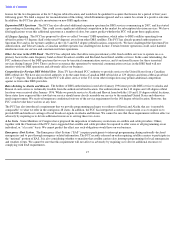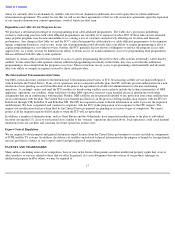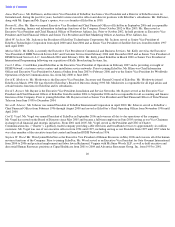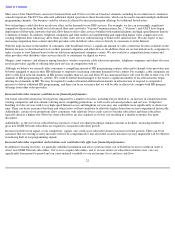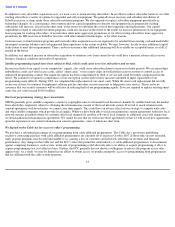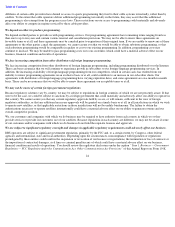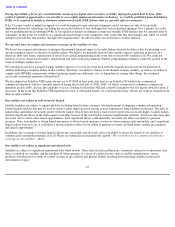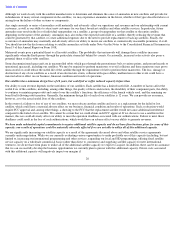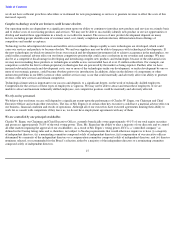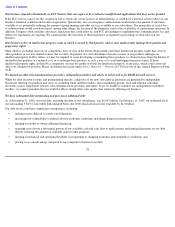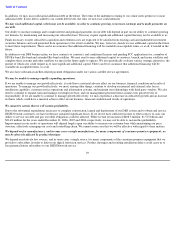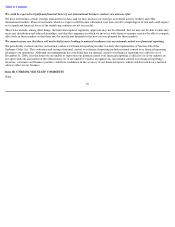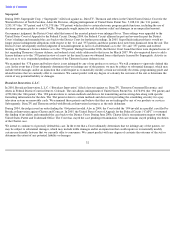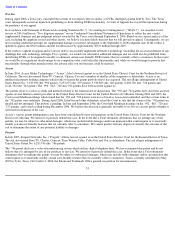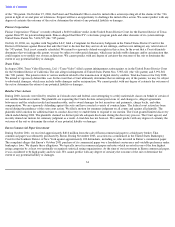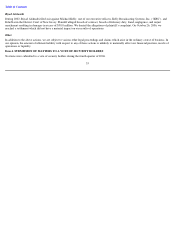Dish Network 2007 Annual Report Download - page 32
Download and view the complete annual report
Please find page 32 of the 2007 Dish Network annual report below. You can navigate through the pages in the report by either clicking on the pages listed below, or by using the keyword search tool below to find specific information within the annual report.
Table of Contents
During April 2006, a Texas jury concluded that certain of our digital video recorders, or DVRs, infringed a patent held by Tivo. If the
verdict is upheld on appeal and we are not able to successfully implement alternative technology, we could be prohibited from distributing
DVRs, or be required to modify or eliminate certain user
-friendly DVR features that we currently offer to consumers.
If the Tivo jury verdict is upheld on appeal, we could be required to pay substantial damages, and if we were not able to successfully
implement alternative technology (including the successful defense of any challenge that such technology infringes Tivo’s patent), we could
also be prohibited from distributing DVRs, or be required to modify or eliminate certain user-friendly DVR features that we currently offer to
consumers. In that event we would be at a significant disadvantage to our competitors who could offer this functionality and, while we would
attempt to provide that functionality through other manufacturers, the adverse affect on our business could be material.
We currently have no commercial insurance coverage on the satellites we own.
We do not use commercial insurance to mitigate the potential financial impact of in-orbit failures because we believe that the premium costs
are uneconomical relative to the risk of satellite failure. We believe we generally have in-orbit satellite capacity sufficient to recover, in a
relatively short time frame, transmission of most of our critical programming in the event one of our in-orbit satellites fails. We could not,
however, recover certain local markets, international and other niche programming. Further, programming continuity cannot be assured in the
event of multiple satellite losses.
We currently do not have adequate backup satellite capacity to recover all of the local network channels broadcast from our EchoStar X
satellite following a complete failure of that satellite. Therefore, our ability to deliver local channels in many markets, as well as our ability to
comply with SHVERA requirements without incurring significant additional costs, is dependent on, among other things, the continued
successful commercial operation of EchoStar X.
We also depend on EchoStar VIII to provide service to CONUS at least until such time as our EchoStar XI satellite has commenced
commercial operation, which is currently expected during the second half of 2008. AMC-14, which is expected to commence commercial
operation in early 2008, also has the capability to act as a backup for EchoStar VIII and could be launched to the 110 degree orbital location, if
necessary. In the event that EchoStar VIII experienced a total or substantial failure, we could transmit many, but not all, of those channels from
other in-orbit satellites.
Our satellites are subject to risks related to launch.
Satellite launches are subject to significant risks, including launch failure, incorrect orbital placement or improper commercial operation.
Certain launch vehicles that may be used by us have either unproven track records or have experienced launch failures in the past. The risks of
launch delay and failure are usually greater when the launch vehicle does not have a track record of previous successful flights. Launch failures
result in significant delays in the deployment of satellites because of the need both to construct replacement satellites, which can take more than
two years, and to obtain other launch opportunities. Such significant delays could materially and adversely affect our ability to generate
revenues. If we were unable to obtain launch insurance, or obtain launch insurance at rates we deem commercially reasonable, and a significant
launch failure were to occur, it could have a material adverse effect on our ability to generate revenues and fund future satellite procurement
and launch opportunities.
In addition, the occurrence of future launch failures may materially and adversely affect our ability to insure the launch of our satellites at
commercially reasonable premiums, if at all. Please see further discussion under the caption “ We currently have no commercial insurance
coverage on our satellites ” above.
Our satellites are subject to significant operational risks.
Satellites are subject to significant operational risks while in orbit. These risks include malfunctions, commonly referred to as anomalies, that
have occurred in our satellites and the satellites of other operators as a result of various factors, such as satellite manufacturers’ errors,
problems with the power systems or control systems of the satellites and general failures resulting from operating satellites in the harsh
environment of space.
25


